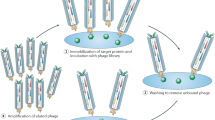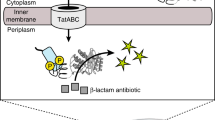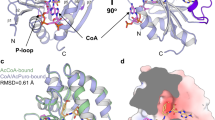Abstract
Phage display has demonstrated the utility of cyclic peptides as general protein ligands but cannot access proteins inside eukaryotic cells. Expanding a new chemical genetics tool, we describe the first expressed library of head-to-tail cyclic peptides in yeast (Saccharomyces cerevisiae). We applied the library to selections in a yeast model of α-synuclein toxicity that recapitulates much of the cellular pathology of Parkinson's disease. From a pool of 5 million transformants, we isolated two related cyclic peptide constructs that specifically reduced the toxicity of human α-synuclein. These expressed cyclic peptide constructs also prevented dopaminergic neuron loss in an established Caenorhabditis elegans Parkinson's model. This work highlights the speed and efficiency of using libraries of expressed cyclic peptides for forward chemical genetics in cellular models of human disease.
This is a preview of subscription content, access via your institution
Access options
Subscribe to this journal
Receive 12 print issues and online access
$259.00 per year
only $21.58 per issue
Buy this article
- Purchase on Springer Link
- Instant access to full article PDF
Prices may be subject to local taxes which are calculated during checkout





Similar content being viewed by others
References
Driggers, E.M., Hale, S.P., Lee, J. & Terrett, N.K. The exploration of macrocycles for drug discovery — an underexploited structural class. Nat. Rev. Drug Discov. 7, 608–624 (2008).
Burja, A.M., Banaigs, B., Abou-Mansour, E., Burgess, J.G. & Wright, P.C. Marine cyanobacteria—a prolific source of natural products. Tetrahedron 57, 9347–9377 (2001).
Wilson, D.S., Keefe, A.D. & Szostak, J.W. The use of mRNA display to select high-affinity protein-binding peptides. Proc. Natl. Acad. Sci. USA 98, 3750–3755 (2001).
Kehoe, J.W. & Kay, B.K. Filamentous phage display in the new millennium. Chem. Rev. 105, 4056–4072 (2005).
Scott, C.P., Abel-Santos, E., Wall, M., Wahnon, D.C. & Benkovic, S.J. Production of cyclic peptides and proteins in vivo. Proc. Natl. Acad. Sci. USA 96, 13638–13643 (1999).
Horswill, A.R., Savinov, S.N. & Benkovic, S.J. A systematic method for identifying small-molecule modulators of protein-protein interactions. Proc. Natl. Acad. Sci. USA 101, 15591–15596 (2004).
Horswill, A.R. & Benkovic, S.J. Cyclic peptides, a chemical genetics tool for biologists. Cell Cycle 4, 552–555 (2005).
Scott, C.P., Abel-Santos, E., Jones, A.D. & Benkovic, S.J. Structural requirements for the biosynthesis of backbone cyclic peptide libraries. Chem. Biol. 8, 801–815 (2001).
Tavassoli, A. et al. Inhibition of HIV budding by a genetically selected cyclic peptide targeting the Gag-TSG101 interaction. ACS Chem. Biol. 3, 757–764 (2008).
Cheng, L. et al. Discovery of antibacterial cyclic peptides that inhibit the ClpXP protease. Protein Sci. 16, 1535–1542 (2007).
Nilsson, L.O., Louassini, M. & Abel-Santos, E. Using siclopps for the discovery of novel antimicrobial peptides and their targets. Protein Pept. Lett. 12, 795–799 (2005).
Kinsella, T.M. et al. Retrovirally delivered random cyclic peptide libraries yield inhibitors of interleukin-4 signaling in human B cells. J. Biol. Chem. 277, 37512–37518 (2002).
Winderickx, J. et al. Protein folding diseases and neurodegeneration: lessons learned from yeast. Biochim. Biophys. Acta 1783, 1381–1395 (2008).
Duennwald, M.L., Jagadish, S., Muchowski, P.J. & Lindquist, S. Flanking sequences profoundly alter polyglutamine toxicity in yeast. Proc. Natl. Acad. Sci. USA 103, 11045–11050 (2006).
Willingham, S., Outeiro, T.F., DeVit, M.J., Lindquist, S.L. & Muchowski, P.J. Yeast genes that enhance the toxicity of a mutant huntingtin fragment or α-synuclein. Science 302, 1769–1772 (2003).
Outeiro, T.F. & Lindquist, S. Yeast cells provide insight into alpha-synuclein biology and pathobiology. Science 302, 1772–1775 (2003).
Cooper, A.A. et al. α-Synuclein blocks ER-Golgi traffic and Rab1 rescues neuron loss in Parkinson's models. Science 313, 324–328 (2006).
Gitler, A.D. et al. The Parkinson's disease protein alpha-synuclein disrupts cellular Rab homeostasis. Proc. Natl. Acad. Sci. USA 105, 145–150 (2008).
Polymeropoulos, M.H. et al. Mutation in the alpha-synuclein gene identified in families with Parkinson's disease. Science 276, 2045–2047 (1997).
Spillantini, M.G. et al. α-Synuclein in Lewy bodies. Nature 388, 839–840 (1997).
Lee, V.M.Y. & Trojanowski, J.Q. Mechanisms of Parkinson's disease linked to pathological alpha-synuclein: new targets for drug discovery. Neuron 52, 33–38 (2006).
Gitler, A.D. et al. α-Synuclein is part of a diverse and highly conserved interaction network that includes PARK9 and manganese toxicity. Nat. Genet. 41, 308–315 (2009).
Ramirez, A. et al. Hereditary parkinsonism with dementia is caused by mutations in ATP13A2, encoding a lysosomal type 5 P-type ATPase. Nat. Genet. 38, 1184–1191 (2006).
Evans, T.C. Jr. & Xu, M.-Q. Mechanistic and kinetic considerations of protein splicing. Chem. Rev. 102, 4869–4883 (2002).
Ghosh, I., Sun, L. & Xu, M.-Q. Zincinhibition of protein trans-splicing and identification of regions essential for splicing and association of a split intein. J. Biol. Chem. 276, 24051–24058 (2001).
Sun, P. et al. Crystal structures of an intein from the split dnaE gene of Synechocystis sp. PCC6803 reveal the catalytic model without the penultimate histidine and the mechanism of zinc ion inhibition of protein splicing. J. Mol. Biol. 353, 1093–1105 (2005).
Naumann, T.A., Savinov, S.N. & Benkovic, S.J. Engineering an affinity tag for genetically encoded cyclic peptides. Biotechnol. Bioeng. 92, 820–830 (2005).
Tavassoli, A. & Benkovic, S.J. Split-intein mediated circular ligation used in the synthesis of cyclic peptide libraries in E. coli. Nat. Protoc. 2, 1126–1133 (2007).
Bickle, M.B.T., Dusserre, E., Moncorge, O., Bottin, H. & Colas, P. Selection and characterization of large collections of peptide aptamers through optimized yeast two-hybrid procedures. Nat. Protoc. 1, 1066–1091 (2006).
Yocum, R.R., Hanley, S., West, R. & Ptashne, M. Use of lacZ fusions to delimit regulatory elements of the inducible divergent GAL1-GAL10 promoter in Saccharomyces cerevisiae. Mol. Cell. Biol. 4, 1985–1998 (1984).
Outeiro, T.F. et al. Sirtuin 2 inhibitors rescue alpha-synuclein-mediated toxicity in models of Parkinson's disease. Science 317, 516–519 (2007).
Ding, Y. et al. Crystal structure of a mini-intein reveals a conserved catalytic module involved in side chain cyclization of asparagine during protein splicing. J. Biol. Chem. 278, 39133–39142 (2003).
Burdine, L. & Kodadek, T. Target identification in chemical genetics: the (often) missing link. Chem. Biol. 11, 593–597 (2004).
Tavassoli, A. & Benkovic, S.J. Genetically selected cyclic-peptide inhibitors of AICAR transformylase homodimerization. Angew. Chem. Int. Ed. Engl. 44, 2760–2763 (2005).
Cao, S., Gelwix, C.C., Caldwell, K.A. & Caldwell, G.A. Torsin-mediated protection from cellular stress in the dopaminergic neurons of Caenorhabditis elegans. J. Neurosci. 25, 3801–3812 (2005).
Hamamichi, S. et al. Hypothesis-based RNAi screening identifies neuroprotective genes in a Parkinson's disease model. Proc. Natl. Acad. Sci. USA 105, 728–733 (2008).
Ellgaard, L. & Ruddock, L.W. The human protein disulphide isomerase family: substrate interactions and functional properties. EMBO Rep. 6, 28–32 (2005).
Abou-Sleiman, P.M., Muqit, M.M.K. & Wood, N.W. Expanding insights of mitochondrial dysfunction in Parkinson's disease. Nat. Rev. Neurosci. 7, 207–219 (2006).
Cabrele, C., Fiori, S., Pegoraro, S. & Moroder, L. Redox-active cyclic bis(cysteinyl)peptides as catalysts for in vitro oxidative protein folding. Chem. Biol. 9, 731–740 (2002).
Kersteen, E.A. & Raines, R.T. Catalysis of protein folding by protein disulfide isomerase and small-molecule mimics. Antioxid. Redox Signal. 5, 413–424 (2003).
Olanow, C.W. Manganese-induced parkinsonism and Parkinson's disease. in Redox-Active Metals in Neurological Disorders vol. 1012 (ed. LeVine, S.M.) 209–223 (New York Academy of Sciences, New York, 2004).
Hoon, S. et al. An integrated platform of genomic assays reveals small-molecule bioactivities. Nat. Chem. Biol. 4, 498–506 (2008).
van der Putten, H. et al. Neuropathology in mice expressing human alpha-synuclein. J. Neurosci. 20, 6021–6029 (2000).
Rual, J.F. et al. Towards a proteome-scale map of the human protein-protein interaction network. Nature 437, 1173–1178 (2005).
Yu, H. et al. High-quality binary protein interaction map of the yeast interactome network. Science 322, 104–110 (2008).
Li, S. et al. A map of the interactome network of the metazoan C. elegans. Science 303, 540–543 (2004).
Brenner, S. Genetics of Caenorhabditis elegans. Genetics 77, 71–94 (1974).
Nass, R., Hall, D.H., Miller, D.M. & Blakely, R.D. Neurotoxin-induced degeneration of dopamine neurons in Caenorhabditis elegans. Proc. Natl. Acad. Sci. USA 99, 3264–3269 (2002).
Acknowledgements
We thank S. Benkovic (Pennsylvania State University) for plasmids, E. Spooner for mass spectrometry assistance and N. Azubuine for preparation of media. This work was supported by a National Research Service Award fellowship from the US National Institute of Neurological Disorders and Stroke (NINDS) and National Institute on Aging (J.A.K.), an R21 grant from NINDS (S.L. and J.A.K.) and the Morris K. Udall Centers of Excellence for Parkinson's Disease Research (S.L.) Parkinson's disease research in the Caldwell Lab (G.A.C, K.A.C., S.H.) was supported by the American Parkinson Disease Association, Michael J. Fox Foundation and US National Institute of Environmental Health Sciences.
Author information
Authors and Affiliations
Contributions
J.A.K. conceived the overall strategy, tested the construct in yeast, designed and constructed the library, performed the selections and all subsequent experiments in yeast, constructed the metazoan CP construct and worm expression plasmids and wrote the manuscript. S.H. constructed the worm lines, designed and performed the worm experiments, analyzed worm data and wrote the manuscript. J.M.M. processed and imaged yeast by electron microscopy. S.S. contributed to the design of the metazoan CP construct. T.A.N. designed and tested the HPQ yeast CP construct. K.A.C. analyzed worm data and wrote the manuscript. G.A.C. designed the worm experiments, analyzed worm data and wrote the manuscript. S.L. suggested the approach, provided advice and suggestions throughout and supervised the project.
Corresponding author
Supplementary information
Supplementary Text and Figures
Supplementary Figures 1–6, Supplementary Tables 1–2, Supplementary Results and Supplementary Methods (PDF 296 kb)
Rights and permissions
About this article
Cite this article
Kritzer, J., Hamamichi, S., McCaffery, J. et al. Rapid selection of cyclic peptides that reduce α-synuclein toxicity in yeast and animal models. Nat Chem Biol 5, 655–663 (2009). https://doi.org/10.1038/nchembio.193
Received:
Accepted:
Published:
Issue Date:
DOI: https://doi.org/10.1038/nchembio.193
This article is cited by
-
Peptide-based approaches to directly target alpha-synuclein in Parkinson’s disease
Molecular Neurodegeneration (2023)
-
Rationally designed cyclic peptides and nanomaterials as ‘next-generation’ anti-amyloid therapeutics
Journal of Materials Science (2023)
-
Methods for generating and screening libraries of genetically encoded cyclic peptides in drug discovery
Nature Reviews Chemistry (2020)
-
Unbiased Screens for Modifiers of Alpha-Synuclein Toxicity
Current Neurology and Neuroscience Reports (2019)
-
Filamentous Virus-based Assembly: Their Oriented Structures and Thermal Diffusivity
Scientific Reports (2018)



